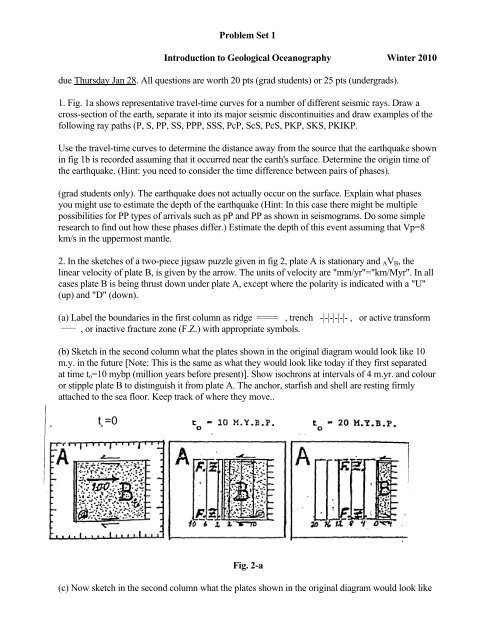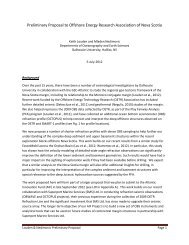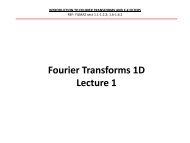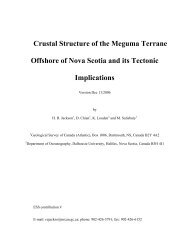Problem Set 1 Introduction to Geological Oceanography Winter ...
Problem Set 1 Introduction to Geological Oceanography Winter ...
Problem Set 1 Introduction to Geological Oceanography Winter ...
You also want an ePaper? Increase the reach of your titles
YUMPU automatically turns print PDFs into web optimized ePapers that Google loves.
<strong>Problem</strong> <strong>Set</strong> 1<br />
<strong>Introduction</strong> <strong>to</strong> <strong>Geological</strong> <strong>Oceanography</strong> <strong>Winter</strong> 2010<br />
due Thursday Jan 28. All questions are worth 20 pts (grad students) or 25 pts (undergrads).<br />
1. Fig. 1a shows representative travel-time curves for a number of different seismic rays. Draw a<br />
cross-section of the earth, separate it in<strong>to</strong> its major seismic discontinuities and draw examples of the<br />
following ray paths (P, S, PP, SS, PPP, SSS, PcP, ScS, PcS, PKP, SKS, PKIKP.<br />
Use the travel-time curves <strong>to</strong> determine the distance away from the source that the earthquake shown<br />
in fig 1b is recorded assuming that it occurred near the earth's surface. Determine the origin time of<br />
the earthquake. (Hint: you need <strong>to</strong> consider the time difference between pairs of phases).<br />
(grad students only). The earthquake does not actually occur on the surface. Explain what phases<br />
you might use <strong>to</strong> estimate the depth of the earthquake (Hint: In this case there might be multiple<br />
possibilities for PP types of arrivals such as pP and PP as shown in seismograms. Do some simple<br />
research <strong>to</strong> find out how these phases differ.) Estimate the depth of this event assuming that Vp=8<br />
km/s in the uppermost mantle.<br />
2. In the sketches of a two-piece jigsaw puzzle given in fig 2, plate A is stationary and AVB, the<br />
linear velocity of plate B, is given by the arrow. The units of velocity are "mm/yr"="km/Myr". In all<br />
cases plate B is being thrust down under plate A, except where the polarity is indicated with a "U"<br />
(up) and "D" (down).<br />
(a) Label the boundaries in the first column as ridge ==== , trench -|-|-|-|-|- , or active transform<br />
_____ , or inactive fracture zone (F.Z.) with appropriate symbols.<br />
(b) Sketch in the second column what the plates shown in the original diagram would look like 10<br />
m.y. in the future [Note: This is the same as what they would look like <strong>to</strong>day if they first separated<br />
at time <strong>to</strong>=10 mybp (million years before present)]. Show isochrons at intervals of 4 m.yr. and colour<br />
or stipple plate B <strong>to</strong> distinguish it from plate A. The anchor, starfish and shell are resting firmly<br />
attached <strong>to</strong> the sea floor. Keep track of where they move..<br />
t=0<br />
0<br />
Fig. 2-a<br />
(c) Now sketch in the second column what the plates shown in the original diagram would look like
20 m.y. in the future. Don't be reluctant <strong>to</strong> use a pair of scissors - even the experts do!<br />
3. Magnetic lineations in the north-eastern Pacific, which impinge upon the Aleutian trench (fig 3),<br />
appear <strong>to</strong> form an oblique angle known as the "Great Magnetic Bight" or GMB (fig 4).<br />
(a) Two profiles across these anomalies and on either side of the GMB are shown in fig 5, <strong>to</strong>gether<br />
with models simulated from the magnetic reversal time scale. Identify these anomalies using the<br />
magnetic reversal time scale shown in lecture 4 Figure 20 and Table 1. Use your knowledge (or the<br />
work of others: which is <strong>to</strong> say in the readings!) <strong>to</strong> give an estimated age before attempting a detailed<br />
identification. Remember that in trying <strong>to</strong> identify the anomalies you are looking for a particular<br />
pattern (ie time series) of reversals <strong>to</strong> match with the model. Using the ages of these identifications,<br />
calculate the spreading rate and spreading direction of the ridge.<br />
(b) These calculations predict that the spreading centre that produced these anomalies subducted<br />
beneath the Aleutian trench in the geologic past. Which sketch in <strong>Problem</strong> 2 represents a similar<br />
situation? What do you think the geologic consequences of this might have been? Where else have<br />
such events occurred in the geologic past? Where is a similar event occurring now?<br />
4. An oceanographic research vessel takes a heat-flow measurement, which gives the following<br />
results:<br />
Depth Temperature Conductivity<br />
m °C W/m-K<br />
0.00 2.000 1.000<br />
0.45 2.021 0.985<br />
0.90 2.043 0.830<br />
1.35 2.081 0.870<br />
1.80 2.112 0.891<br />
2.25 2.138 0.899<br />
2.70 2.157 0.905<br />
3.15 2.197 0.853<br />
3.60 2.228 0.839<br />
4.00 2.258 0.883<br />
(a) What is the geothermal heat flow from these measurements, as determined by the mean<br />
conductivity and temperature gradient over the entire depth range (0-4m)?<br />
(b) What is the age of the ocean floor assuming that there is no error in the measurement? What<br />
depth is expected for this age?<br />
(c) (grad students only) The heat flow value actually has an error of +/- 5%. What error would there<br />
be in expected age and water depth? Assuming that we can measure basement depth <strong>to</strong> an<br />
accuracy of about +/- 50 m, what error would that produce in the estimate of age?<br />
5. (grad students only) The mean heat loss at the earth's surface has been estimated at 3.05 x 10 13 W.<br />
Estimate what percentage of this comes from ocean crust 0-15 Myr old. Assume that the <strong>to</strong>tal length<br />
of the mid-ocean ridge system is 50,000 km and assume that it is spreading at an average <strong>to</strong>tal rate of<br />
6 cm/yr (i.e. 3 cm/yr on each side).<br />
(a) Calculate the amount of conductive heat loss from crust 0-15 Myr old that is predicted from the<br />
theoretical model of a cooling plate. You can calculate this by integrating the equation for heatflow
as a function of time [ q = 470/sqrt(t)], where q is in mW/m 2 and t is in m.y. [If your integral calculus<br />
is <strong>to</strong>o rusty, you can proceed by discrete summation of average values for each m.y., ie 0-1, 1-2, etc.<br />
In this case, avoid the problem of infinite heat flow at t=0 by assuming an average flow of 920<br />
mW/m 2 for crust 0-1 Myr old, which is what more complex theories predict.]<br />
(b) Use the data for fast spreading ridges shown in lecture 6 Figure 2a <strong>to</strong> determine the amount of<br />
conductive heat loss from 0-15 Myr old crust that is actually observed. Why is this less than<br />
predicted by the theoretical models?
Fig 1A<br />
Fig 1B. Each time mark represents 1 minute. Z,N,E represent the 3 components of<br />
the seismometers. Note that the time marks in part A are offset for the various<br />
components. Part B represents a more detailed image of the initial arrivals.
Fig. 5<br />
Fig. 3<br />
Fig. 4









